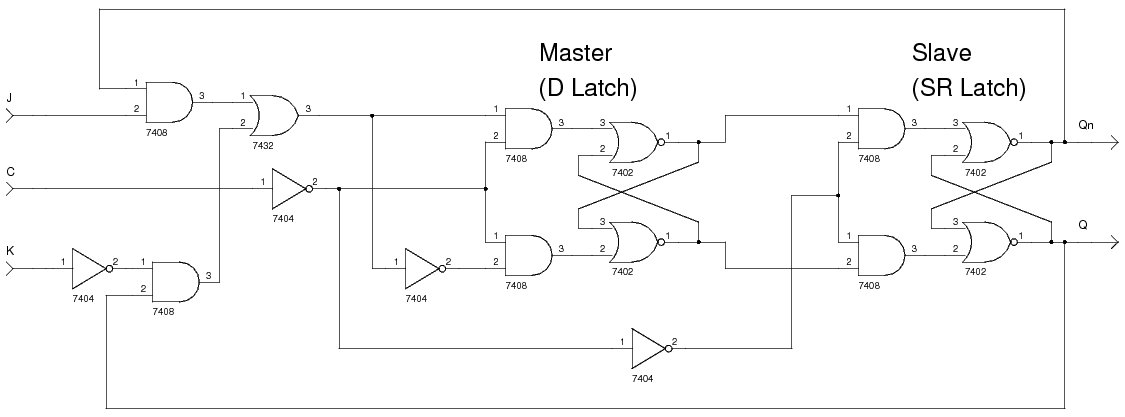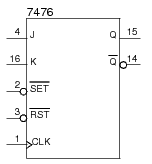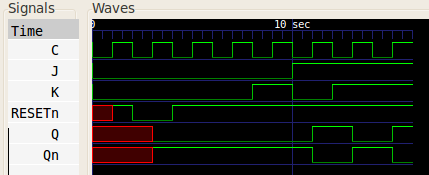JK Flip-Flop (edge-triggered)
A JK flip-flop is used in clocked sequential logic circuits to store one bit of data.
It is almost identical in function to a SR flip-flop, the only difference being the
elimination of the undefined state where both S and R are 1.
In the case of a JK flip-flop, when the equivalent inputs are both 1, the outputs toggle.
The type of JK flip-flop described here is an edge-triggered JK flip-flop.
It is built from two gated latches: one a master gated D latch, and the other a slave
gated SR latch.
This is a modified edge-triggered D flip-flop — the flip-flop's outputs
are fed back and combined with the inputs.
The master takes the flip-flop's inputs: J (set), K (reset), and C (clock).
The clock input is inverted and fed into the D latch's gate input.
The slave takes the master's outputs as inputs (Q to S and Qn to R),
and the complement of the master's clock input.
The slave's outputs are the flip-flop's outputs.
This difference in clock inputs between the two latches disconnects them and
eliminates the transparency between the flip-flop's inputs and outputs.
The schematic below shows a positive edge triggered JK flip-flop.
The two inputs J and K are used to set and reset the data respectively.
They can also be used to toggle the data.
The clock input C is used to control both the master and slave latches making sure only one of the latches can set its data at
any given time.
When C has the value 0, the master latch can set its data and the slave latch cannot.
When C has the value 1, the slave can set its data and the master cannot.
When C transitions from 0 to 1 the master has its outputs set which reflect the flip-flop's inputs when the
transition occurred.
The outputs Q and Qn are the flip-flop's stored data and the complement of the flip-flop's stored data respectively.

The schematic symbol for a 7476 edge-triggered JK flip-flop is shown below. This chip has inputs to asynchronously set and reset the flip-flop's data.

Example
The following function table shows the operation of a JK flip-flop. The column header Q(t+1) means
"the value of Q at the start of the next clock period", similarly for Qn(t+1).
J |
K |
Q(t+1) |
Qn(t+1) |
Meaning |
|---|---|---|---|---|
0 | 0 | Q | Qn | Hold |
0 | 1 | 0 | 1 | Reset |
1 | 0 | 1 | 0 | Set |
1 | 1 | Qn | Q | Toggle |
Verilog
Below is the Verilog code for a positive edge-triggered JK flip-flop. An active low reset input has been added to asynchronously clear the flip-flop. The code for the gated D and SR latches is also shown for completeness.
module jk_flip_flop_edge_triggered(Q, Qn, C, J, K, RESETn);
output Q;
output Qn;
input C;
input J;
input K;
input RESETn;
wire Kn; // The complement of the K input.
wire D;
wire D1; // Data input to the D latch.
wire Cn; // Control input to the D latch.
wire Cnn; // Control input to the SR latch.
wire DQ; // Output from the D latch, inputs to the gated SR latch (S).
wire DQn; // Output from the D latch, inputs to the gated SR latch (R).
assign D1 = !RESETn ? 0 : D; // Upon reset force D1 = 0
not(Kn, K);
and(J1, J, Qn);
and(K1, Kn, Q);
or(D, J1, K1);
not(Cn, C);
not(Cnn, Cn);
d_latch dl(DQ, DQn, Cn, D1);
sr_latch_gated sr(Q, Qn, Cnn, DQ, DQn);
endmodule // jk_flip_flop_edge_triggered
module d_latch(Q, Qn, G, D);
output Q;
output Qn;
input G;
input D;
wire Dn;
wire D1;
wire Dn1;
not(Dn, D);
and(D1, G, D);
and(Dn1, G, Dn);
nor(Qn, D1, Q);
nor(Q, Dn1, Qn);
endmodule // d_latch
module sr_latch_gated(Q, Qn, G, S, R);
output Q;
output Qn;
input G;
input S;
input R;
wire S1;
wire R1;
and(S1, G, S);
and(R1, G, R);
nor(Qn, S1, Q);
nor(Q, R1, Qn);
endmodule // sr_latch_gated
A simulation with test inputs gave the following wave form:

References
Kleitz, W. Digital Microprocessor Fundamentals. 3rd Edition. Prentice Hall, 2000.
Mano, M. Morris, and Kime, Charles R. Logic and Computer Design Fundamentals. 2nd Edition. Prentice Hall, 2000.